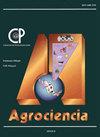羊用含和不含羊果的日粮的化学分析及原位降解
IF 0.5
4区 农林科学
Q4 AGRICULTURE, MULTIDISCIPLINARY
引用次数: 0
摘要
在干旱时期的牛牧场,chote (Parmentiera aculeata (Kunth) L.O.)的果实。这里有威廉姆斯,吃草的反刍动物很满意地吃掉了它。然而,这种水果的营养价值和干物质的瘤胃可利用性(其营养特性归因于此)尚不清楚。目的是利用原位降解法评估巧克力果在绵羊日粮中的降解情况,并确定瘤胃中的一些生理变量。选取6只活重为30±2 kg的瘤胃瘘管羔羊,试验日粮为:t0: 0%巧克力果;t15:15 %巧克力水果,t30:30 %巧克力水果。采用3 × 3交叉设计,测定了巧克力果的原位降解情况,并对试验饲粮进行了分析。结果表明,3 h和6 h后,t30的巧克力果降解程度最高(p≤0.05)。24、48和72 h后,pH和氨氮(N-NH3)无统计学差异(p >0.05)。乙酸、丙酸和丁酸的产率无显著差异(p >0.05), t15(乙酸= 77.81 mM L-1;丙酸= 14.39 mM L-1;丁酸= 0。67 mM L-1)和t30(乙酸= 77.21 mM L-1;丙酸= 18.52 mM L-1;丁酸= 8.97 mM L-1),但均大于T 0(乙酸= 62.03 mM L-1,丙酸= 18.52 mM L-1,丁酸= 9.27 mM L-1)。综上所述,在绵羊日粮中添加30% chote可提高降解率,但不影响瘤胃各项指标。本文章由计算机程序翻译,如有差异,请以英文原文为准。
CHEMICAL ANALYSIS AND in situ DEGRADATION OF DIETS PREPARED WITH AND WITHOUT FRUIT OF Parmentiera aculeata (Kunth) L.O. Williams IN SHEEP
During the drought period in cattle pastures, the fruits of chote (Parmentiera aculeata (Kunth) L.O.) Williams are available, which are satisfactorily consumed by grazing ruminants. However, the nutritional value and ruminal availability of the dry matter of this fruit, to which nutritional properties are attributed, are unknown. The objective was to evaluate the degradation of chote fruit for inclusion in sheep diets using in situ degradation and to identify some physiological variables in the rumen. Six rumen fistulated lambs with a live weight of 30 ± 2 kg were adapted for 11 days to the following experimental diets: T 0: 0 % chote fruit; T 15: 15 % chote fruit, and T 30: 30 % chote fruit. In situ degradation of chote fruit was determined and experimental diets were analyzed with a 3 × 3 crossover design. The results show that after 3 and 6 h, chote fruit at T 30 presented greater degradation (p ≤ 0.05). After 24, 48, and 72 h, pH and ammonia nitrogen (N-NH3) showed no statistical differences (p > 0.05). The yields of acetic, propionic, and butyric acids were not different (p > 0.05) at T 15 (acetic acid = 77.81 mM L-1; propionic = 14.39 mM L-1; butyric = 0. 67 mM L-1) and T 30 (acetic acid = 77.21 mM L-1; propionic = 18.52 mM L-1; butyric = 8.97 mM L-1), but both were greater than T 0 (acetic = 62.03 mM L-1, propionic = 18.52 mM L-1, butyric = 9.27 mM L-1). In conclusion, the addition of 30 % chote to sheep diets increases degradation without affecting ruminal variables.
求助全文
通过发布文献求助,成功后即可免费获取论文全文。
去求助
来源期刊

Agrociencia
农林科学-农业综合
CiteScore
0.50
自引率
33.30%
发文量
51
审稿时长
18-36 weeks
期刊介绍:
AGROCIENCIA is a scientific journal created and sponsored by the Colegio de Postgraduados. Its main objective is the publication and diffusion of agricultural, animal and forestry sciences research results from mexican and foreign scientists. All contributions are peer reviewed. Starting in the year 2000, AGROCIENCIA became a bimonthly and fully bilingual journal (Spanish and English versions in the same issue). Since 2007 appears every month and a half (eight issues per year). In addition to the printed issues, the full content is available in electronic format.
 求助内容:
求助内容: 应助结果提醒方式:
应助结果提醒方式:


